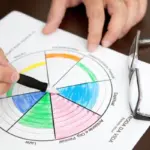How can we identify our emotions? What is the wheel of emotions technique for? Discover one of the most useful strategies in psychology to understand your emotions.

When we are in a difficult time in our lives, complicated and overwhelming emotions can come into play. When we have all these sensations inside us, it can be very difficult to figure out what exactly we are feeling and how to act on these feelings. The wheel of emotions It is a strategy developed to be able to handle ourselves better during these moments. Discover how to use it and what it consists of to be able to better manage your emotions.
What is the wheel of emotions?
The wheel of emotions It consists of a psychological tool that allows us to identify and verbalize emotions that are more complex. Within this ‘circle’ of emotions we can identify eight primary human emotions and various levels to qualify these sensations. Primary emotions are those that will guide the strategy to identify what we feel. Then, as we get closer to the edges of the wheel of emotions, we can find the nuances that can help us better define the emotion we feel.
Plutchik’s Wheel of Emotions
The psychologist Robert Plutchik was the one who developed this wheel of emotions Therefore, this technique is also known as the Plutchik wheel. In this strategy to identify emotions, Plutchik stated that there were eight basic emotions in psychology. Therefore, he organized them into opposite pairs within this circle of emotions.
- sadness and joy
- anger and fear
- Expectation and surprise
- Acceptance and disgust
According to their theories, these basic emotions they can be identified, become ‘softer’ or combine with others to produce any of the emotions we feel.

What are the combinations of the wheel of emotions?
In order to respond most effectively to our emotions, it is important to know ourselves inside and learn to detect what is happening inside us. Through the wheel of emotions, people can know their emotional states through the combinations of the wheel of the different basic emotions of psychology.
- Sadness: Includes feelings of sadness, depression, discontent, apathy, hopelessness, loneliness and lethargy. Within Plutchik’s theories, contrasting emotions are those that include joy.
- Gonna: It refers to an unpleasant mental experience felt due to real or imagined harm that has been done to an individual or what an individual values. The contrasting emotion is fear.
- Disgust: Refers to the feelings of aversion, repulsion and rejection that people can experience when faced with contact or the idea of it. The contrasting emotion is trust.
- Happiness: It gives us a deep feeling of satisfaction. This emotion is vital to perform successful repetitive behaviors. The contrasting emotion is sadness.
- Trust: Involves feelings related to hope, security and belief in others and oneself. The contrasting emotion is disgust.
- Fear: It is similar to experiencing nervousness, worry, uncertainty, anxiety or terror. Biologically, it helps us avoid the dangers around us. The contrasting emotion is anger.
- Surprise: The emotion of surprise stimulates our interest. Their contrasting emotion is anticipation.
- Anticipation: Irritation, pleasure, expectations and everything related to what is expected from some event or action. These emotions are usually associated with an adaptation to future events. Its contrasting emotion is surprise.
How to use the wheel of emotions?
The Plutchik wheel It can help us deal with and understand our emotions. This means being able to cope better with stressful situations and learning to make decisions that are more in line with what we really want. In order to use the wheel of emotions, we can do the following.
Analyze the physical sensations in your body and then identify whether you are experiencing a primary or secondary emotion. Start with the basic emotions and then continue until you find the word that describes your emotional experience within the circle of emotions. Plutchik’s emotions
There really is no right or wrong way to use the wheel of life template. What matters most is having the vocabulary to be able to support yourself when you need it and better identify these emotions.

What is the wheel of emotions for?
Knowing yourself helps avoid spirals of negative thoughts. In this way, understanding what happens inside us allows us to simplify what is happening to us, increasing self-expression and self-compassion for ourselves. Therefore, use a classification of emotions allows us to benefit from the following.
- Avoid obsessive thoughts: By knowing how we react to different actions and what emotions are related to it, people can avoid those negative thoughts that can harm them.
- Connect better with others: The circle of emotions allows us to help ourselves communicate better with others. This is because if we can identify an emotion through words, we can express it to others and understand each other more.
- Emotional maturity: Maturity implies being able to manage emotions better and therefore have more emotional intelligence. In this way, through the wheel of emotions people can learn to name, control and express their emotions.
- See emotions from another perspective: Being able to distance ourselves from our emotions allows us to have more control over our actions and thoughts.
Emotions are part of our daily lives. If you think you cannot identify them, it is important to take the help of a psychology professional since this can lead to many problems in both your personal and professional life. Know how to control and understand them through techniques such as wheel of emotions, It can be very beneficial for our mental health.








